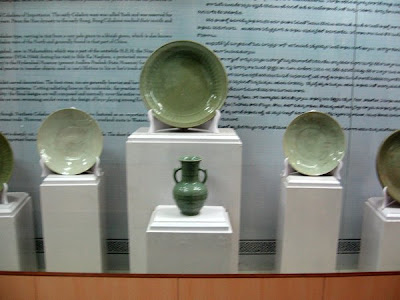Most museums do not allow photography at all. And I find it very irritating. For instance, during my last month’s visit to Hyderabad, when I visited the famous Salar Jung Museum, I was so disappointed to learn that cameras were not allowed inside. Damn.
We could click pictures of the museum from outside, I was told. Huh
Worst of all, mobile phones were allowed inside. And these days, even the lowest end mobiles have cameras. People were shooting pictures of anything and everything, and I kept kicking myself for not having carried one. I really wanted to click a few pictures of the Veiled Rebecca. It was so lovely. You can read more about this statue and the sculptor here.
Anyways, I still don’t understand why photography cannot be allowed inside museums and monasteries. What harm can it cause? When so many objects were kept in the open at Salar Jung Museum. So many people kept on touching these objects. I tried to prevent some, but who would care. I myself got tired of the exercise after a while. Better allow photography than let people touch and damage these objects.
And perhaps, that is exactly why, I was happy when I visited the Andhra Pradesh Archeological Museum. Photography was allowed and to get the permission, one had to just buy a ticket. Cool!
However, please note that in museums most of the articles are on display behind glass partitions, to prevent visitors from touching and damaging these centuries’ old artifacts and articles. But it is usually never too easy to shoot pictures through glass. The most common problems relate to flash shining back and reflections. Then there are some who wouldn’t allow the use of flash. Good! That prevents light shining back. However, the low-light conditions are not good enough for decent photography. The results are usually not very good either. However, I got lucky at the AP Archeological Museum. Here are some pictures that I would like to share with you.
We could click pictures of the museum from outside, I was told. Huh
Worst of all, mobile phones were allowed inside. And these days, even the lowest end mobiles have cameras. People were shooting pictures of anything and everything, and I kept kicking myself for not having carried one. I really wanted to click a few pictures of the Veiled Rebecca. It was so lovely. You can read more about this statue and the sculptor here.
Anyways, I still don’t understand why photography cannot be allowed inside museums and monasteries. What harm can it cause? When so many objects were kept in the open at Salar Jung Museum. So many people kept on touching these objects. I tried to prevent some, but who would care. I myself got tired of the exercise after a while. Better allow photography than let people touch and damage these objects.
And perhaps, that is exactly why, I was happy when I visited the Andhra Pradesh Archeological Museum. Photography was allowed and to get the permission, one had to just buy a ticket. Cool!
However, please note that in museums most of the articles are on display behind glass partitions, to prevent visitors from touching and damaging these centuries’ old artifacts and articles. But it is usually never too easy to shoot pictures through glass. The most common problems relate to flash shining back and reflections. Then there are some who wouldn’t allow the use of flash. Good! That prevents light shining back. However, the low-light conditions are not good enough for decent photography. The results are usually not very good either. However, I got lucky at the AP Archeological Museum. Here are some pictures that I would like to share with you.




Please let me know what you think of these pictures. Post your comments.


No comments:
Post a Comment